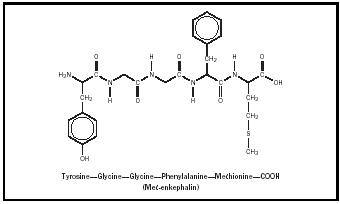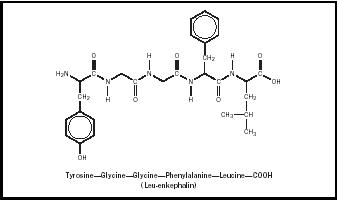Endorphins

Endorphins are small neuropeptides that are produced by the body and act to reduce pain—hence, the name endorphin (a shortened version of endogenous morphine). The term "enkephalin" (meaning literally "in the head") is also applied to endorphins, but usually refers to smaller molecules that have pain-relieving properties.
Endorphins were discovered when scientists found sites where molecules such as morphine bind to nerve cells and reasoned that the body must use these sites to bind chemical compounds. Experiments showed that the compounds were small peptides, and the actions of endorphins were determined by a number of researchers.
Although similar in primary structure to proteins, endorphins are smaller, ranging from five to forty or more amino acids in length. Endorphins are not considered to be neurotransmitter molecules, but are instead classified as neuromodulatory, that is, they modify the action of neurotransmitters through a number of effects associated with pain or pleasure.
Protein molecules are often synthesized in long chains by the body and cut apart to form functional individual protein units. β -endorphin molecules are produced by the body as portions of larger proopiomelanocortin (POMC) molecules, which are coded for by a single gene, synthesized as large molecules, and then cut by enzymes into active subunits. POMC also contains several hormones. The β -endorphin molecules function to relieve pain or produce pleasurable feelings and contain within their structure the pentapeptides met-enkephalin and leu-enkephalin. Composed of five amino acids joined by amide linkages, met-enkephalin (see Figure 1) and leuenkephalin (see Figure 2) differ only in the amino acid present at the carboxylic acid (C-terminal) end.

A wide range of physiological effects has been observed for endorphins, but the ultimate function and number of endorphins may not yet be known. Endorphins exhibit a number of neurological effects associated with the relief of pain. The administration of exogenous endorphins (those prepared outside the body) stimulates the release of many other hormones including prolactin, adrenocorticotropic hormone (ACTH), and antidiuretic hormone. The analgesic effects of morphine are commonly believed to be caused by binding to receptor sites for endorphins, but few beneficial effects of treatment with exogenous endorphins have been reported.
Early speculations concerning the function of endorphins suggested that they were natural painkillers that the body produced to alleviate pain in circumstances requiring an individual to continue functioning in spite of injury or stress. Examples of such situations might include childbirth, exercise, and combat. In addition to affecting one's perception of pain, endorphins may be involved in other phenomena such as runner's high and acupuncture. Persons who exercise regularly have higher than usual amounts of β -endorphin

in their bloodstream, and the levels of β -endorphin molecules increase during exercise, perhaps accounting for the enhanced feelings of well-being experienced by long-distance runners. Acupuncturists insert and manipulate long needles at precise locations on the skin. After insertion of the needles, patients experience a reduction in pain or may have other physiological responses. In some cases, the stimulation of these acupuncture points by massage may result in the release of endorphins into the blood. Practices such as squeezing the upper lip to stifle a sneeze or massaging the fleshy area between the thumb and forefinger to alleviate a headache may be related to endorphin effects.
Healthy humans are able to overcome stress and pain, allowing them to continue functioning without being overcome by either. To some degree the response is probably psychological, but evidence that the endorphin effect is real exists in the relationship of the opioid-like drug naloxone to the placebo effect. Given a placebo (a so-called sugar pill), many patients report a decrease in pain. The placebo effect is reduced if naloxone, a drug used to treat the intoxicating effects of narcotics, is administered. The administration of naloxone also reduces the endorphin effect; if given naloxone, patients report increased sensitivity to pain. In addition, abnormal levels of endorphins may be associated with mental illness such as autism or depression. For example, an autistic patient might produce so much endogenous endorphin that he or she does not need to react to the world outside, and a depressed person might not produce enough endorphin to withstand the pain and pressures of daily life.
SEE ALSO Neurotransmitters ; Peptide Bond .
Dan M. Sullivan
Bibliography
Devlin, Thomas M., ed. (2002). Textbook of Biochemistry: With Clinical Correlations, 5th edition. New York: Wiley-Liss.
McKee, Trudy, and McKee, James R. (2003). Biochemistry: The Molecular Basis of Life, 3rd edition. Boston: McGraw-Hill.
Snyder, S. (1986). Drugs and the Brain. New York: W.H. Freeman.
I would love to know something more about exogenous endorphins.
Could you please help me with some more information?
Esther Baart